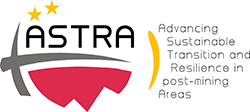Almadén Mining Park
38º 39' 44'' N 5º 15' 12'' W
Almadén, Ciudad Real, Castilla La Mancha
Spain
Description
Almaden Mines are the largest mercury mines of the world, extracting a third part of the global mercury production.
Extracted Materials
Mercury
Cinnabar
Antropological info
This exploitation was probably discovered by Phoenicians and Carthaginians, but its documentation begun in the 4th century BC with the roman invasion of the Iberian Peninsula. It was used as a dye. During muslim occupation, the place received its current name: Almadén. From the 12th century, the Spanish Crown owned the mines and all its resources.
Nowadays, health problems associated with mercury, along with the current low profitability, has made Almadén mines cease its activity.
Nevertheless, the mines have become a touristic attraction that offers a real mining experience.
Sociologal info
Due to mine workers health problems and environmental impact, the European laws decreed the cessation of the mining extraction and the metallurgic activity in 2001 and 2003 respectively. There is still a large cinnabar deposit that hasn’t been exploited yet.
The mines were named as “Global Geosite” by the Geological and Mining Institute of Spain. In 2012, Almadén’s mines gained the consideration of “World Heritage” by the UNESCO.
Archaeological info
Almadén mines have been exploited since ancient times. They are the largest mercury deposit in the world.
Almaden mines have produced more than 35% of the mercury obtained globally, more than double that the second largest mercury mine (Idrija, Slovenia). The extracted ore was cinnabar (mercury sulphur) and less commonly, quartzites and native mercury.
In addition, Almadén’s landscapes and ecological wealth make this village a touristic interest. Its biodiversity includes boars, vultures or deer, as well as holm oaks or cork oaks.
Sustainable tourism insights
There are guided tours available. Superficial mine installation and old workshops can be visited, as well as San Aquilino and San Teodoro shafts. Before entering the underground galleries, basic mining knowledge is taught in the Mining Interpretation Centre.
The tour inside the mine goes down 50 metres deep, in a mine cage. There, you can visit a real mine exploited in the 16th and 17th century, with real mining conditions (mining helmet and traditional mining lamps). The tour goes on in the Mercury Museum, where we can find information about local geology and palaeontology, with interactive physics experiments and metallurgic history. If you want to live a real mining experience, come visit Almadén mines!
Environment sustainability
Due to health problems associated with mercury, the mine was forced to stop its activity. However, this incredible place has become a touristic attraction. The mine has been reconditioned for visitors to access, without risk or danger. Almadén mines are a great example of taking advantage of the available resources to turn an abandoned place into an incredible experience.
Creativity insights/curiosities
Mercury was historically used for gold and silver extraction. In a similar way to alchemy, mercury can swallow these metals literally. It can also evaporate at a relative low temperature (300 ºC). When mercury is evaporated, gold and silver can be extracted. This method was used by old thieves for stealing.









